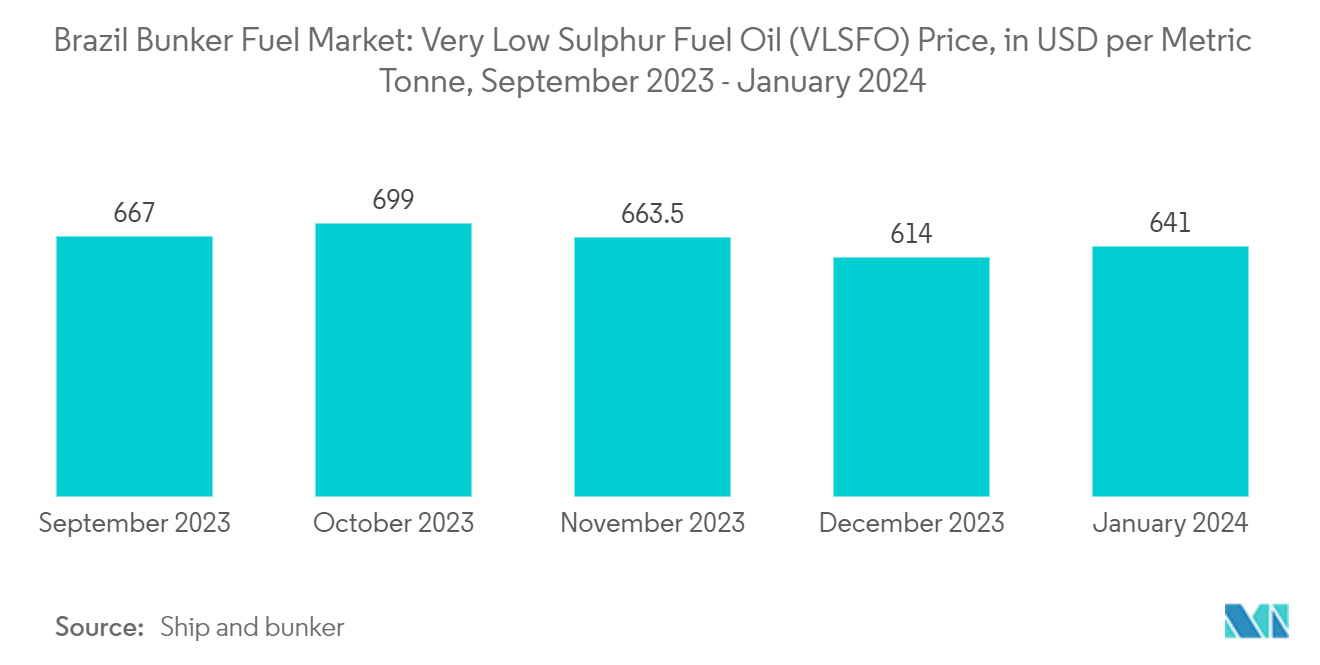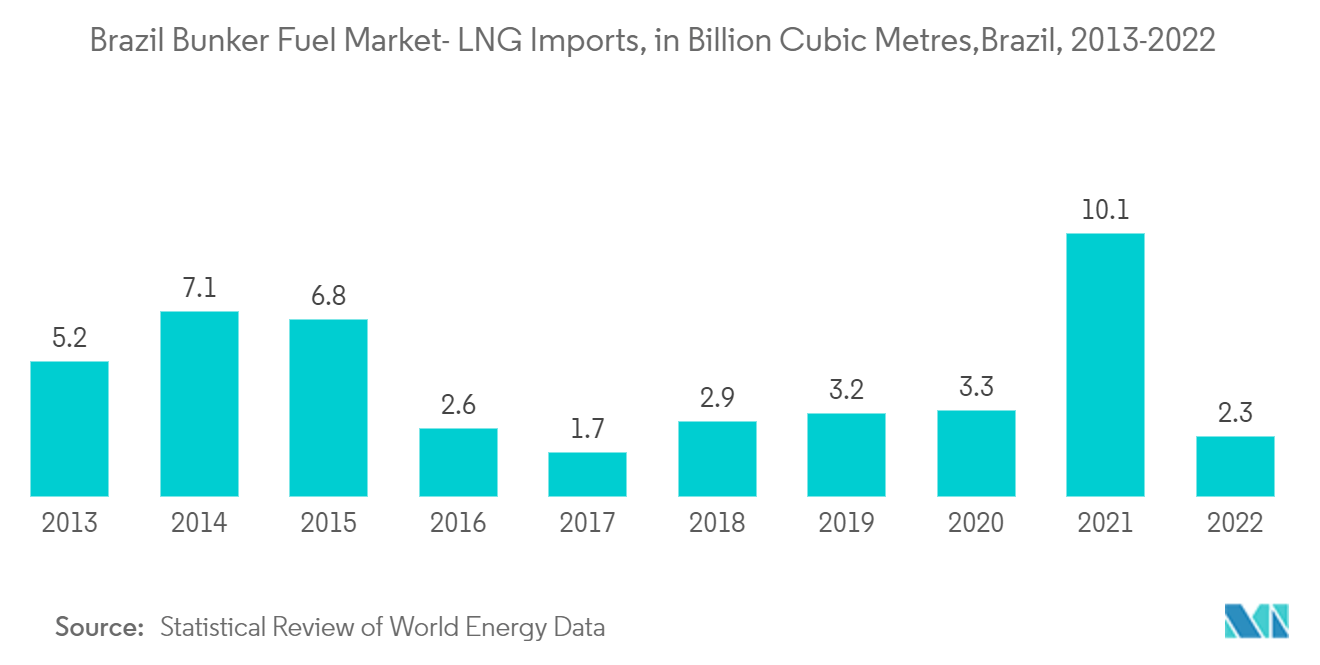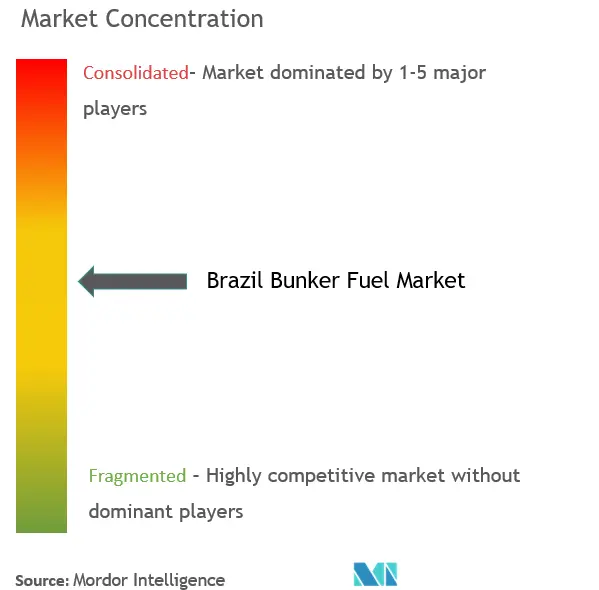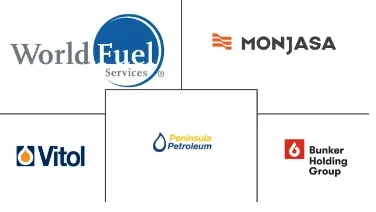Brazil Bunker Fuel Market Size and Share

Brazil Bunker Fuel Market Analysis by Mordor Intelligence
The Brazil Bunker Fuel Market size is estimated at USD 2.41 billion in 2025, and is expected to reach USD 3.40 billion by 2030, at a CAGR of 7.1% during the forecast period (2025-2030).
- Factors such as rising demand for cleaner bunker fuels due to the implementation of more restrictive environmental regulations and the growing trade of LNG for the power sector in the regions are expected to drive the market during the forecast period.
- On the other hand, changes in the cost of bunker fuel and crude oil are expected to hinder the market's growth.
- Nevertheless, the number of ships in service and the demand for maritime transportation are expected to create several future market opportunities during the forecast period.
Brazil Bunker Fuel Market Trends and Insights
Very Low Sulphur Fuel Oil (VLSFO) to Witness Significant Growth
- Bunker fuels have a high sulfur content and may emit harmful fumes. Different methods can be employed to lower the sulfur concentration. Ultra-low-sulfur fuel oil is one of the varieties of bunker fuels. With an IMO regulation going into effect in January 2020, there was a growing need for very low sulfur fuel oil (VLSFO), which has a sulfur concentration of less than 0.5%.
- The majority of the market for high-sulfur fuel oil (HSFO) is anticipated to be replaced by low-sulfur substitutes. The majority of VLSFO that is sold on the market is made of residual and distillate components combined with different cutters with distinct viscosities and sulfur contents to produce a product that meets specifications.
- The government is focusing on refineries by increasing their capacity and fulfilling the demand for very low-sulfur fuel oil (VLSFO). The government is also planning to increase exploration and development in the region with the help of Petronas. Petrobras' strategy from 2023 to 2027 includes USD 78 billion in capital expenditures, with 83% going to exploration and production and 63% going to pre-salt development. The region has 53 FPSOs, which is significantly greater than the North Sea or any other offshore oil and gas emphasis. Brazil is increasing its investment in the region and bringing in new partners to help it grow.
- Moreover, due to IMO regulation, the nation is more dependent on VLSFO bunkers, and the companies are now more focused on selling only VLSFO fuel-based bunkers. In October 2023, Brazilian fuel distributor Ipiranga entered the Rio Grande do Sul bunker market. Ipiranga commenced supplying two types of bunker, namely VLSFO (very low sulfur fuel oil) and LSMGO (low-sulfur marine gasoil), which comply with ISO 8217: 2010 specifications and IMO 2020 standards. All these initiatives are likely to create the demand for VLSFO-type fuel during the forecast period.
- According to Ship and Bunker, the price of VLSFO was reported as USD 641 per metric tonne in January 2024, which increased by 4.4% as compared to December 2023. The price growth is due to the increased demand for VLSFO fuel in the region.
- Hence, driven by high domestic demand, recent developments, and upcoming projects, the region is expected to drive the demand for the market during the forecast period.

LNG as a Bunker Fuel is Likely to Witness Significant Growth
- The Brazilian LNG bunkering industry has developed over the last decade, driven by increased global LNG usage, clean energy demand, and the opportunity to minimize greenhouse gas emissions. LNG-powered vessels are becoming progressively higher in demand, and lower natural gas prices signaled the start of an expansion in the market for these kinds of vessels.
- The cost of converting the current operational vessels to LNG-powered vessels is significant. It is, therefore, not feasible economically. After the new pollution restrictions take effect, LNG-based vessels are anticipated to have the lowest operating costs of all the fuel options. Furthermore, a gradual transition from conventional ship fuelling methods, such as heavy fuel oil, marine gas oil, marine diesel oil, etc., to LNG propulsion is more advantageous. A ship's operational efficiency can be increased, and its carbon footprint will be significantly reduced with LNG-based propulsion.
- The demand for LNG as a bunker fuel is increasing exponentially, and the companies in the region are focusing on increasing the process of regenerating natural gas to LNG and fulfilling the increased demand for LNG as a bunker fuel. In October 2023, the state-owned oil and gas Petrobras of Brazil entered into a ten-year agreement with Texas-based LNG business Excelerate Energy to lease the floating storage and regasification unit (FSRU) Sequoia. Additionally, the acquisition broadens the company's primary operation of regasification, increasing insight into predictable short- and long-term cash flows and earnings.
- Moreover, in December 2023, New Fortress Energy (NFE), a US energy business, signed a definitive agreement to acquire Ceiba Energy's 1.6 GW capacity reserve contract (PortoCem PPA). The company plans to strategically expand its power complex by 1.2 GW using the infrastructure that is now in place at Barcarena. Commercial operations for the expansion are anticipated to begin in 2026. It is still planned for NFE's initial 630 MW development in Barcarena to begin commercial operations in the third quarter of 2025. These agreements may increase the demand for LNG during the forecast period and create future opportunities for the organization.
- According to the Statistical Review of World Energy Data, LNG imports were reported at 2.3 billion cubic meters in 2022, reduced by 55.7% compared to 2013. Imports are likely to increase in the coming years as the government focuses on increasing refinery capacity by signing multiple deals.
- Hence, driven by high domestic demand, recent developments, and upcoming projects, the region is expected to drive the demand for the market during the forecast period.

Competitive Landscape
The Brazilian bunker fuel market is semi-consolidated. Some of the key players in this market include Bunker Holding A/S, Monjasa Holding A/S, AP Moeller Maersk A/S, World Fuel Services Corp., and Peninsula Petroleum Ltd.
Brazil Bunker Fuel Industry Leaders
Bunker Holding A/S
World Fuel Services Corp
Monjasa Holding A/S
AP Moeller Maersk A/S
Peninsula Petroleum Ltd
- *Disclaimer: Major Players sorted in no particular order

Recent Industry Developments
- September 2023: Acelen, the largest bunker manufacturer in the Brazilian state of Bahia, joined with Bunker Holding's subsidiary Bunker One, which announced that it would provide the country's first outside anchorage bunkering operation. The anchorage area at the Port of Itaqui in São Marcos Bay (MA) can accommodate vessels, including tankers and large cargo ships.
- November 2022: Nimofast Brasil SA and the Norwegian company Kanfer Shipping AS signed a collaboration agreement to develop small and medium-sized LNG shipping, small-scale floating storage units (FSU), and LNG bunkering solutions in Brazil starting in 2025.
Brazil Bunker Fuel Market Report Scope
Bunker fuel refers to any fuel pumped into a ship's bunkers to power its combustion engines. Deep-sea cargo ships often burn the heavy, residual oil that remains after gasoline, diesel, and other light hydrocarbons are removed from crude oil during the refining process.
The Brazilian bunker fuel market is segmented by capacity and vessel type. By type, the market is segmented into high-sulfur fuel oil (HSFO), very low-sulfur fuel oil (VLSFO), marine gas oil (MGO), liquefied natural gas (LNG), and other fuel types. By vessel type, the market is segmented into containers, tankers, general cargo, bulk carriers, and other vessel types. For each segment, the market size and forecasts have been done based on revenue (USD).
| High Sulfur Fuel Oil (HSFO) |
| Very-low Sulfur Fuel Oil (VLSFO) |
| Marine Gas Oil (MGO) |
| Other Fuel Types |
| Containers |
| Tankers |
| General Cargo |
| Bulk Carrier |
| Other Vessel Types |
| By Fuel Type | High Sulfur Fuel Oil (HSFO) |
| Very-low Sulfur Fuel Oil (VLSFO) | |
| Marine Gas Oil (MGO) | |
| Other Fuel Types | |
| By Vessel Type | Containers |
| Tankers | |
| General Cargo | |
| Bulk Carrier | |
| Other Vessel Types |
Key Questions Answered in the Report
How big is the Brazil Bunker Fuel Market?
The Brazil Bunker Fuel Market size is expected to reach USD 2.41 billion in 2025 and grow at a CAGR of 7.10% to reach USD 3.40 billion by 2030.
What is the current Brazil Bunker Fuel Market size?
In 2025, the Brazil Bunker Fuel Market size is expected to reach USD 2.41 billion.
Who are the key players in Brazil Bunker Fuel Market?
Bunker Holding A/S, World Fuel Services Corp, Monjasa Holding A/S, AP Moeller Maersk A/S and Peninsula Petroleum Ltd are the major companies operating in the Brazil Bunker Fuel Market.
What years does this Brazil Bunker Fuel Market cover, and what was the market size in 2024?
In 2024, the Brazil Bunker Fuel Market size was estimated at USD 2.24 billion. The report covers the Brazil Bunker Fuel Market historical market size for years: 2019, 2020, 2021, 2022, 2023 and 2024. The report also forecasts the Brazil Bunker Fuel Market size for years: 2025, 2026, 2027, 2028, 2029 and 2030.
Page last updated on:
Brazil Bunker Fuel Market Report
Statistics for the 2025 Brazil Bunker Fuel market share, size and revenue growth rate, created by Mordor Intelligence™ Industry Reports. Brazil Bunker Fuel analysis includes a market forecast outlook for 2025 to 2030 and historical overview. Get a sample of this industry analysis as a free report PDF download.



